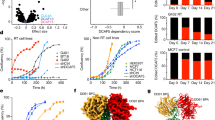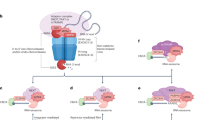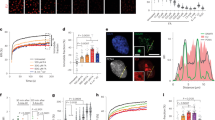Abstract
THE c-myc protein (Myc) contains an amino-terminal transcriptional activation domain1 and a carboxy-terminal basic helix–loop–helix–leucine zipper (bHLH-Z) domain2–5 that directs dimerization of Myc with its partner, the max protein (Max), and promotes DNA binding to sites containing a CACGTG core consensus sequence6–9. Despite these characteristics and the observation that Myc can modulate gene expression4,5,10, a direct role for Myc or Max as transcription factors has never been demonstrated. Here we use Saccharomyces cerevisiae as an in vivo model system to show that the Myc protein is a sequence-specific transcriptional activator whose DNA binding is strictly dependent on dimerization with Max. Transactivation is mediated by the amino-terminal domain of Myc. We find that Max homodimers bind to the same DNA sequence as Myc + Max but that they fail to transactivate and thus can antagonize Myc + Max function. We also show that the Max HLH-Z domain has a higher affinity for the Myc HLH-Z domain than for itself, and suggest that the heterodimeric Myc + Max activator forms preferentially at equilibrium.
This is a preview of subscription content, access via your institution
Access options
Subscribe to this journal
Receive 51 print issues and online access
$199.00 per year
only $3.90 per issue
Buy this article
- Purchase on Springer Link
- Instant access to full article PDF
Prices may be subject to local taxes which are calculated during checkout
Similar content being viewed by others
References
Kato, G. J., Barrett, J., Villa, G. M. & Dang, C. V. Molec. cell. Biol. 10, 5914–5920 (1990).
Murre, C., McCaw, P. S. & Baltimore, D. Cell 56, 777–783 (1989).
Landschulz, W. H., Johnson, P. F. & McKnight, S. L. Science 240, 1759–1764 (1988).
Penn, L. J. Z., Laufer, E. M. & Land, H. in Seminars in Cancer Biology Vol. 1 (ed. Jones, N.) 69–80 (Saunders, London, 1990).
Luscher, B. & Eisenman, R. N. Genes Dev. 4, 2025–2035 (1990).
Blackwell, T. K., Kretzner, L., Blackwood, E. M., Eisenman, R. N. & Weintraub, H. Science 250, 1149–1151 (1990).
Blackwood, E. M. & Eisenman, R. N. Science 251, 1211–1217 (1991).
Prendergast, G. C., Lawe, D. & Ziff, E. B. Cell 65, 395–407 (1991).
Littlewood, T. D., Amati, B., Land, H. & Evan, G. I. Oncogene 7, 1783–1792 (1992).
Eilers, M., Schirm, S. & Bishop, J. M. EMBO J. 10, 133–141 (1991).
Kato, G. J., Lee, W. M. F., Chen, L. & Dang, C. V. Genes Dev. 6, 81–92 (1992).
Berberich, S. & Cole, M. D. Genes Dev. 6, 166–176 (1992).
Fisher, F., Jayaraman, P. S. & Goding, C. R. Oncogene 6, 1099–1104 (1991).
Makela, T. P., Koskinen, P. J., Vastrik, I. & Alitalo, K. Science 256, 373–377 (1992).
Dalton, S. & Treisman, T. Cell 68, 597–612 (1992).
Fields, S. & Song, O. Nature 340, 245–246 (1989).
Ransone, L. J. & Verma, I. M. A. Rev. Cell Biol. 6, 539–557 (1990).
O'Shea, E. K., Rutkowski, R., Stafford, W. III & Kim, P. S. Science 245, 646–648 (1989).
Smeal, T., Angel, P., Meek, J. & Karin, M. Genes Dev. 3, 2091–2100 (1989).
Davis, R. L., Cheng, P. F., Lassar, A. B. & Weintraub, H. Cell 60, 733–746 (1990).
Voronova, A. & Baltimore, D. Proc. natn. Acad. Sci. U.S.A. 87, 4277–4726 (1990).
Lech, K., Anderson, K. & Brent, R. Cell 52, 179–184 (1988).
Stone, J. et al. Molec. cell. Biol. 7, 1697–1709 (1987).
Penn, L. J. Z. et al. Molec. cell. Biol. 10, 4961–4966 (1990).
Evan, G. I. et al. Cell 69, 119–128 (1992).
Blackwood, E. M., Luscher, B. & Eisenman, R. N. Genes Dev. 6, 71–80 (1992).
Kelly, K. & Siebenlist, U. A. Rev. Immun. 4, 317–338 (1986).
Guarente, L. & Mason, T. Cell 32, 1279–1286 (1983).
Gregor, P. D., Sawadogo, M. & Roeder, R. G. Genes Dev. 4, 1730–1740 (1990).
Smith, M. et al. Cell 16, 753–761 (1979).
Harshman, K. D., Moye, R. W. & Parker, C. S. Cell 53, 321–330 (1988).
Author information
Authors and Affiliations
Rights and permissions
About this article
Cite this article
Amati, B., Dalton, S., Brooks, M. et al. Transcriptional activation by the human c-Myc oncoprotein in yeast requires interaction with Max. Nature 359, 423–426 (1992). https://doi.org/10.1038/359423a0
Received:
Accepted:
Issue Date:
DOI: https://doi.org/10.1038/359423a0
This article is cited by
-
Genome-wide identification and characterisation of bHLH transcription factors in Artemisia annua
BMC Plant Biology (2023)
-
c-MYC mediates the crosstalk between breast cancer cells and tumor microenvironment
Cell Communication and Signaling (2023)
-
RUNX3 inactivates oncogenic MYC through disruption of MYC/MAX complex and subsequent recruitment of GSK3β-FBXW7 cascade
Communications Biology (2023)
-
MYCL promotes iPSC-like colony formation via MYC Box 0 and 2 domains
Scientific Reports (2021)
-
Neurobiological Opportunities in Diabetic Polyneuropathy
Neurotherapeutics (2021)
Comments
By submitting a comment you agree to abide by our Terms and Community Guidelines. If you find something abusive or that does not comply with our terms or guidelines please flag it as inappropriate.



